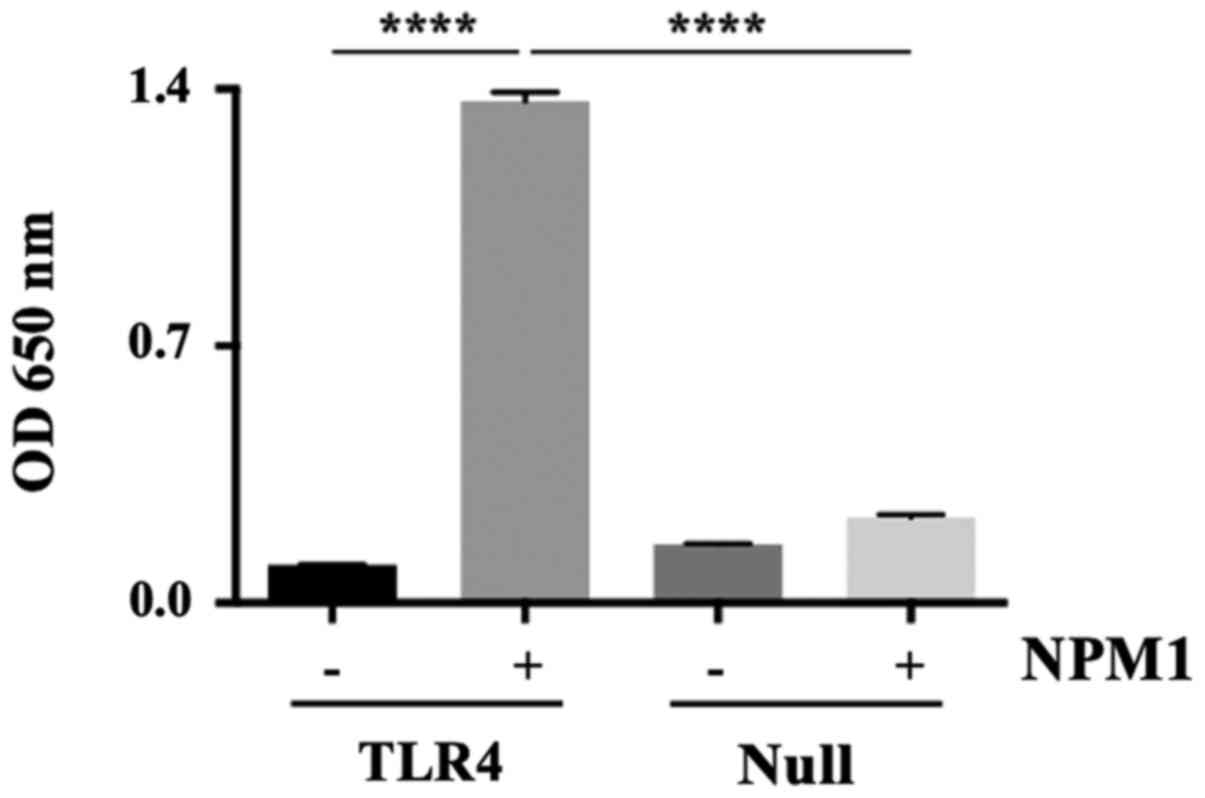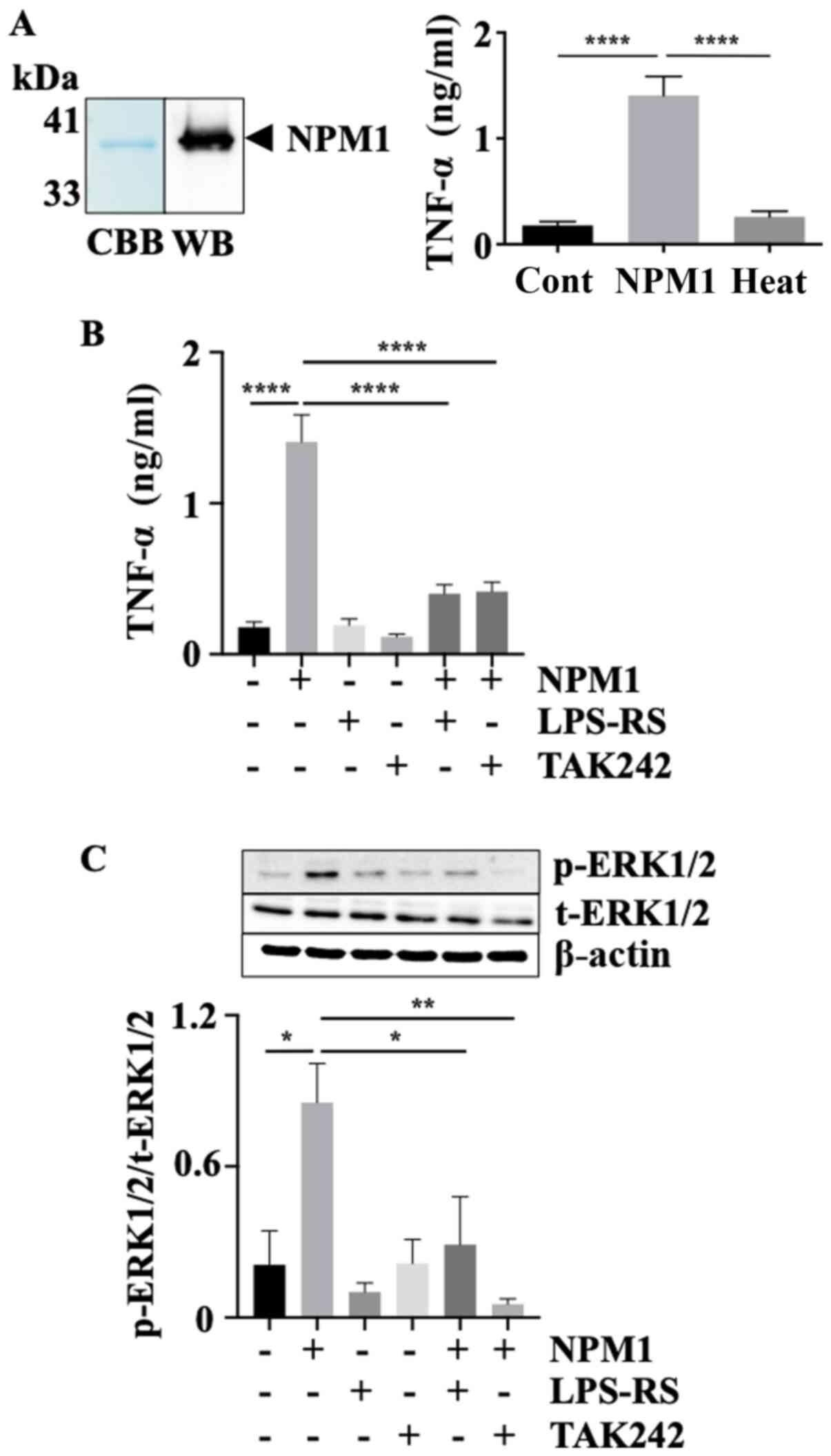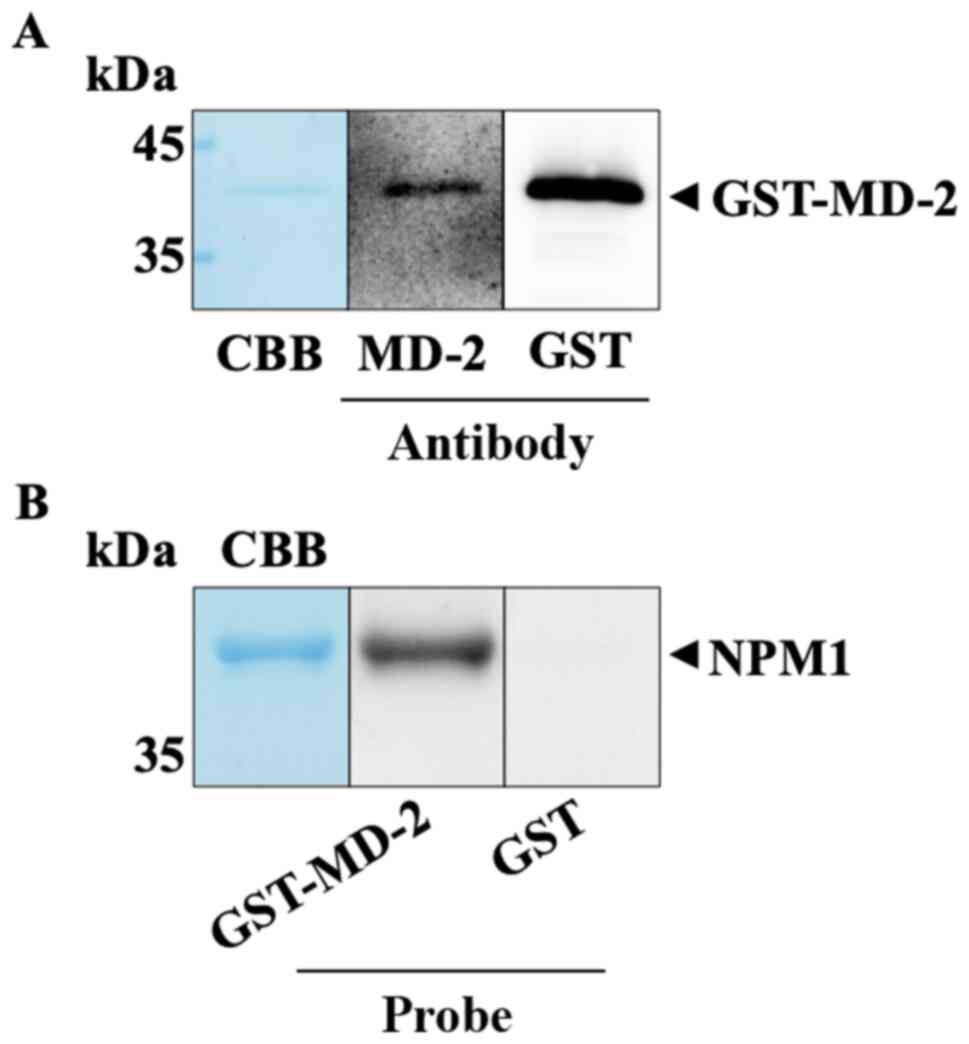|
1
|
Ito T, Totoki T, Yokoyama Y, Yasuda T,
Furubeppu H, Yamada S, Maruyama I and Kakihana Y: Serum histone H3
levels and platelet counts are potential markers for coagulopathy
with high risk of death in septic patients: A single-center
observational study. J Intensive Care. 7(63)2019.PubMed/NCBI View Article : Google Scholar
|
|
2
|
Roh JS and Sohn DH: Damage-associated
molecular patterns in inflammatory diseases. Immune Netw.
18(e27)2018.PubMed/NCBI View Article : Google Scholar
|
|
3
|
Kikuchi K, Kawahara K, Tancharoen S,
Matsuda F, Morimoto Y, Ito T, Biswas KK, Takenouchi K, Miura N,
Oyama Y, et al: The free radical scavenger edaravone rescues rats
from cerebral infarction by attenuating the release of
high-mobility group box-1 in neuronal cells. J Pharmacol Exp Ther.
329:865–874. 2009.PubMed/NCBI View Article : Google Scholar
|
|
4
|
Morimoto Y, Kawahara KI, Tancharoen S,
Kikuchi K, Matsuyama T, Hashiguchi T, Izumi Y and Maruyama I: Tumor
necrosis factor-alpha stimulates gingival epithelial cells to
release high mobility-group box 1. J Periodontal Res. 43:76–83.
2008.PubMed/NCBI View Article : Google Scholar
|
|
5
|
Nawa Y, Kawahara K, Tancharoen S, Meng X,
Sameshima H, Ito T, Masuda Y, Imaizumi H, Hashiguchi T and Maruyama
I: Nucleophosmin may act as an alarmin: Implications for severe
sepsis. J Leukoc Biol. 86:645–653. 2009.PubMed/NCBI View Article : Google Scholar
|
|
6
|
Xu J, Zhang X, Pelayo R, Monestier M,
Ammollo CT, Semeraro F, Taylor FB, Esmon NL, Lupu F and Esmon CT:
Extracellular histones are major mediators of death in sepsis. Nat
Med. 15:1318–1321. 2009.PubMed/NCBI View
Article : Google Scholar
|
|
7
|
Wang H, Bloom O, Zhang M, Vishnubhakat JM,
Ombrellino M, Che J, Frazier A, Yang H, Ivanova S, Borovikova L, et
al: HMG-1 as a late mediator of endotoxin lethality in mice.
Science. 285:248–251. 1999.PubMed/NCBI View Article : Google Scholar
|
|
8
|
Box JK, Paquet N, Adams MN, Boucher D,
Bolderson E, O'Byrne KJ and Richard DJ: Nucleophosmin: From
structure and function to disease development. BMC Mol Biol.
17(19)2016.PubMed/NCBI View Article : Google Scholar
|
|
9
|
Borer RA, Lehner CF, Eppenberger HM and
Nigg EA: Major nucleolar proteins shuttle between nucleus and
cytoplasm. Cell. 56:379–390. 1989.PubMed/NCBI View Article : Google Scholar
|
|
10
|
Yang H, Wang H, Ju Z, Ragab AA, Lundbäck
P, Long W, Valdes-Ferrer SI, He M, Pribis JP, Li J, et al: MD-2 is
required for disulfide HMGB1-dependent TLR4 signaling. J Exp Med.
212:5–14. 2015.PubMed/NCBI View Article : Google Scholar
|
|
11
|
Xu J, Zhang X, Monestier M, Esmon NL and
Esmon CT: Extracellular histones are mediators of death through
TLR2 and TLR4 in mouse fatal liver injury. J Immunol.
187:2626–2631. 2011.PubMed/NCBI View Article : Google Scholar
|
|
12
|
He M, Bianchi ME, Coleman TR, Tracey KJ
and Al-Abed Y: Exploring the biological functional mechanism of the
HMGB1/TLR4/MD-2 complex by surface plasmon resonance. Mol Med.
24(21)2018.PubMed/NCBI View Article : Google Scholar
|
|
13
|
Kuzmich NN, Sivak KV, Chubarev VN, Porozov
YB, Savateeva-Lyubimova TN and Peri F: TLR4 signaling pathway
modulators as potential therapeutics in inflammation and sepsis.
Vaccines (Basel). 5(34)2017.PubMed/NCBI View Article : Google Scholar
|
|
14
|
Coats SR, Pham TT, Bainbridge BW, Reife RA
and Darveau RP: MD-2 mediates the ability of tetra-acylated and
penta-acylated lipopolysaccharides to antagonize Escherichia
coli lipopolysaccharide at the TLR4 signaling complex. J
Immunol. 175:4490–4498. 2005.PubMed/NCBI View Article : Google Scholar
|
|
15
|
Takashima K, Matsunaga N, Yoshimatsu M,
Hazeki K, Kaisho T, Uekata M, Hazeki O, Akira S, Iizawa Y and Ii M:
Analysis of binding site for the novel small-molecule TLR4 signal
transduction inhibitor TAK-242 and its therapeutic effect on mouse
sepsis model. Br J Pharmacol. 157:1250–1262. 2009.PubMed/NCBI View Article : Google Scholar
|
|
16
|
Matsunaga N, Tsuchimori N, Matsumoto T and
Ii M: TAK-242 (resatorvid), a small-molecule inhibitor of Toll-like
receptor (TLR) 4 signaling, binds selectively to TLR4 and
interferes with interactions between TLR4 and its adaptor
molecules. Mol Pharmacol. 79:34–41. 2011.PubMed/NCBI View Article : Google Scholar
|
|
17
|
Visintin A, Halmen KA, Latz E, Monks BG
and Golenbock DT: Pharmacological inhibition of endotoxin responses
is achieved by targeting the TLR4 coreceptor, MD-2. J Immunol.
175:6465–6472. 2005.PubMed/NCBI View Article : Google Scholar
|
|
18
|
Park EK, Jung HS, Yang HI, Yoo MC, Kim C
and Kim KS: Optimized THP-1 differentiation is required for the
detection of responses to weak stimuli. Inflamm Res. 56:45–50.
2007.PubMed/NCBI View Article : Google Scholar
|
|
19
|
Fujita H, Yagishita N, Aratani S,
Saito-Fujita T, Morota S, Yamano Y, Hansson MJ, Inazu M, Kokuba H,
Sudo K, et al: The E3 ligase synoviolin controls body weight and
mitochondrial biogenesis through negative regulation of PGC-1β.
EMBO J. 34:1042–1055. 2015.PubMed/NCBI View Article : Google Scholar
|
|
20
|
Walsh BW, Lenhart JS, Schroeder JW and
Simmons LA: Far western blotting as a rapid and efficient method
for detecting interactions between DNA replication and DNA repair
proteins. Methods Mol Biol. 922:161–168. 2012.PubMed/NCBI View Article : Google Scholar
|
|
21
|
Akashi S, Shimazu R, Ogata H, Nagai Y,
Takeda K, Kimoto M and Miyake K: Cutting edge: Cell surface
expression and lipopolysaccharide signaling via the toll-like
receptor 4-MD-2 complex on mouse peritoneal macrophages. J Immunol.
164:3471–3475. 2000.PubMed/NCBI View Article : Google Scholar
|
|
22
|
Horvatinovich JM, Grogan EW, Norris M,
Steinkasserer A, Lemos H, Mellor AL, Tcherepanova IY, Nicolette CA
and DeBenedette MA: Soluble CD83 inhibits T cell activation by
binding to the TLR4/MD-2 complex on CD14+ monocytes. J
Immunol. 198:2286–2301. 2017.PubMed/NCBI View Article : Google Scholar
|
|
23
|
Krüger CL, Zeuner MT, Cottrell GS, Widera
D and Heilemann M: Quantitative single-molecule imaging of TLR4
reveals ligand-specific receptor dimerization. Sci Signal.
10(eaan1308)2017.PubMed/NCBI View Article : Google Scholar
|
|
24
|
Singh A, Singh V, Tiwari RL, Chandra T,
Kumar A, Dikshit M and Barthwal MK: The IRAK-ERK-p67phox-Nox-2 axis
mediates TLR4, 2-induced ROS production for IL-1β transcription and
processing in monocytes. Cell Mol Immunol. 13:745–763.
2016.PubMed/NCBI View Article : Google Scholar
|
|
25
|
Smith JA, Stallons LJ, Collier JB, Chavin
KD and Schnellmann RG: Suppression of mitochondrial biogenesis
through toll-like receptor 4-dependent mitogen-activated protein
kinase kinase/extracellular signal-regulated kinase signaling in
endotoxin-induced acute kidney injury. J Pharmacol Exp Ther.
352:346–357. 2015.PubMed/NCBI View Article : Google Scholar
|
|
26
|
Luan H, Zhang Q, Wang L, Wang C, Zhang M,
Xu X, Zhou H, Li X, Xu Q, He F, et al: OM85-BV induced the
productions of IL-1β, IL-6, and TNF-α via TLR4- and TLR2-mediated
ERK1/2/NF-κB pathway in RAW264.7 cells. J Interferon Cytokine Res.
34:526–536. 2014.PubMed/NCBI View Article : Google Scholar
|
|
27
|
Cela I, Di Matteo A and Federici L:
Nucleophosmin in its interaction with ligands. Int J Mol Sci.
21(4885)2020.PubMed/NCBI View Article : Google Scholar
|
|
28
|
Mitrea DM, Grace CR, Buljan M, Yun MK,
Pytel NJ, Satumba J, Nourse A, Park CG, Madan Babu M, White SW, et
al: Structural polymorphism in the N-terminal oligomerization
domain of NPM1. Proc Natl Acad Sci USA. 111:4466–4471.
2014.PubMed/NCBI View Article : Google Scholar
|
|
29
|
Chen X, Tao T, Wang H, Zhao H, Lu L and Wu
F: Arterial thrombosis is accompanied by elevated mitogen-activated
protein kinase (MAPK) and Cyclooxygenase-2 (COX-2) expression via
Toll-like receptor 4 (TLR4) activation by S100A8/A9. Med Sci Monit.
24:7673–7681. 2018.PubMed/NCBI View Article : Google Scholar
|
|
30
|
Watanabe T, Takahashi N, Hirabara S,
Ishiguro N and Kojima T: Hyaluronan inhibits TLR4-dependent RANKL
expression in human rheumatoid arthritis synovial fibroblasts. PLoS
One. 11(e0153142)2016.PubMed/NCBI View Article : Google Scholar
|
|
31
|
Blich M, Golan A, Arvatz G, Sebbag A,
Shafat I, Sabo E, Cohen-Kaplan V, Petcherski S, Avniel-Polak S,
Eitan A, et al: Macrophage activation by heparanase is mediated by
TLR-2 and TLR-4 and associates with plaque progression.
Arterioscler Thromb Vasc Biol. 33:e56–e65. 2013.PubMed/NCBI View Article : Google Scholar
|
|
32
|
Lu Z, Zhang X, Li Y, Lopes-Virella MF and
Huang Y: TLR4 antagonist attenuates atherogenesis in LDL
receptor-deficient mice with diet-induced type 2 diabetes.
Immunobiology. 220:1246–1254. 2015.PubMed/NCBI View Article : Google Scholar
|

















